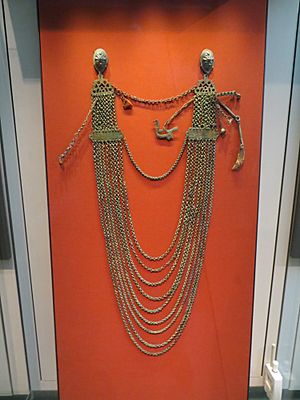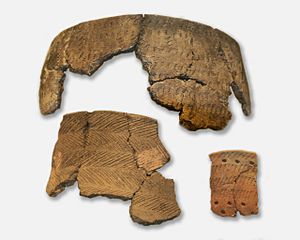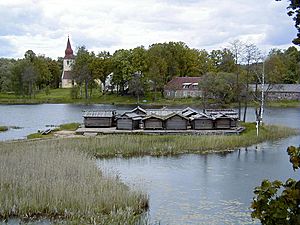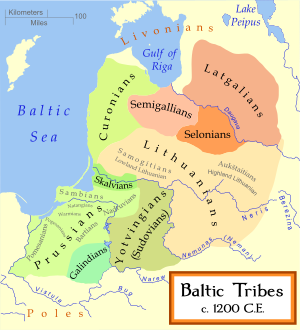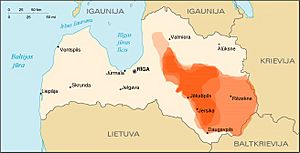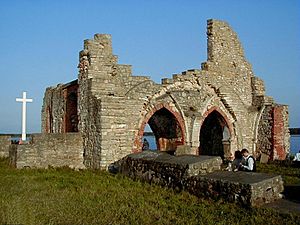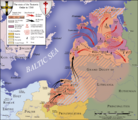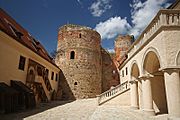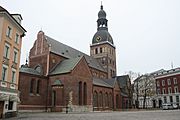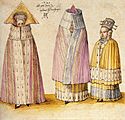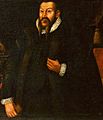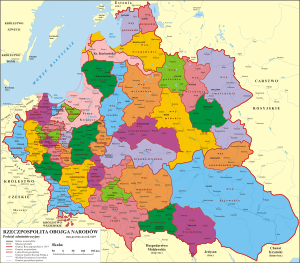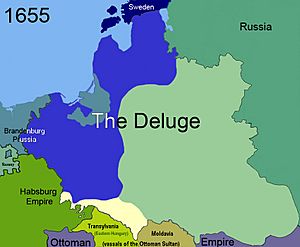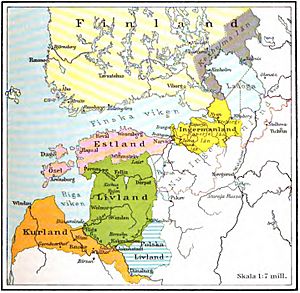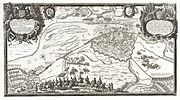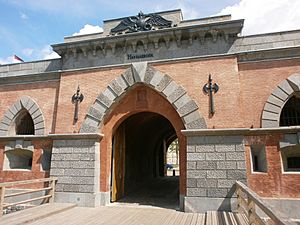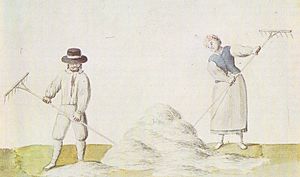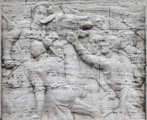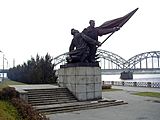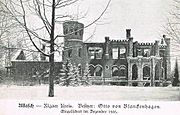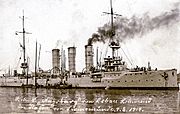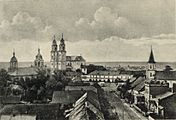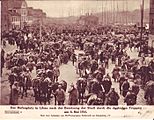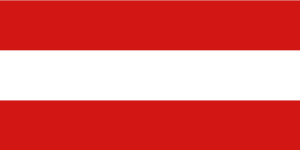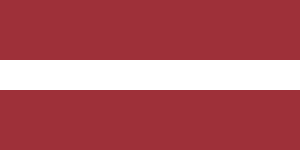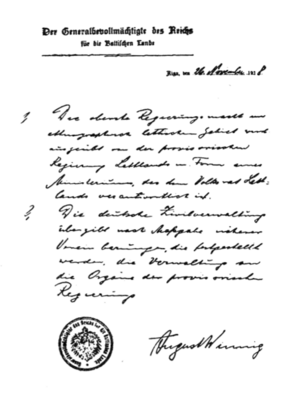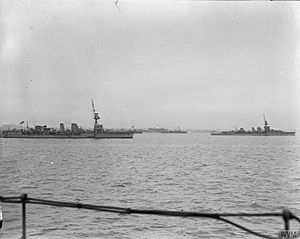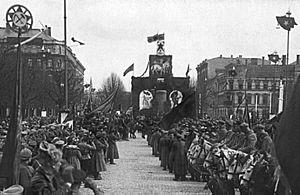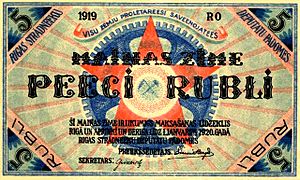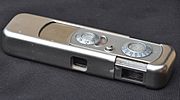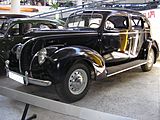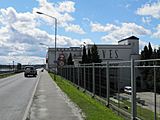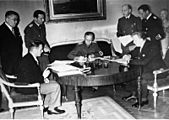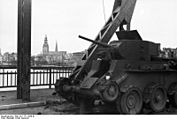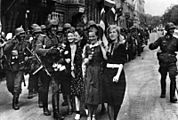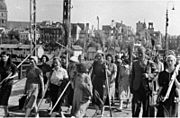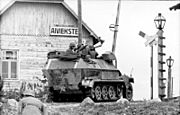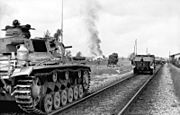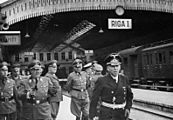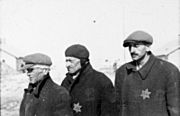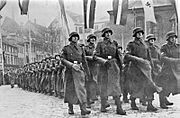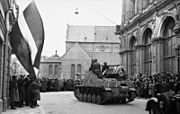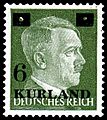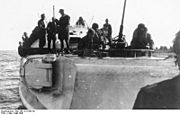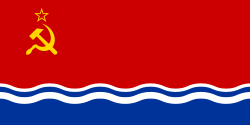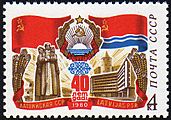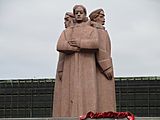History of Latvia facts for kids
The history of Latvia started around 9000 BC when the last Ice Age ended in northern Europe. Ancient Baltic people came to the area about 2000 BC. By the end of the first millennium AD, four main tribal groups lived in Latvia.
Latvia's main river, the Daugava, was part of a big trade route. This route went from the Baltic region through Russia to southern Europe and the Middle East. Vikings and later German traders used it.
In the early Middle Ages, people in the region didn't want to become Christian. They faced attacks during the Northern Crusades. Riga, Latvia's capital, was founded in 1201 by Germans at the Daugava's mouth. It became a key base for the Livonian Brothers of the Sword to conquer the area. Riga was the first big city in the southern Baltic region. After 1282, it became a major trading center in the Hanseatic League.
By the 16th century, other powers started to challenge the Baltic Germans in Terra Mariana. Latvia's location and Riga's busy trade made it a frequent battleground. At least four major powers fought over it: the State of the Teutonic Order, the Polish–Lithuanian Commonwealth, Sweden, and the Russian Empire. The last time an outside power took control was in 1710. This happened when Russia took over Riga and parts of Latvia from Sweden during the Great Northern War.
Under Russian rule, Latvia was a leader in building factories and ending serfdom (when peasants were tied to the land). By the late 1800s, it was one of the most developed parts of the Russian Empire. This led to more social problems and unhappiness. Riga played a big role in the 1905 Russian Revolution.
The First Latvian National Awakening began in the 1850s. It led to Latvia gaining independence after World War I. After two years of fighting in the Latvian War of Independence, Soviet Russia recognized Latvia's freedom in 1920. The world recognized it in 1921. Latvia's Constitution of Latvia was adopted in 1922.
Political problems and the Great Depression led to a government takeover on May 15, 1934, by Prime Minister Kārlis Ulmanis. Latvia's independence was stopped in June–July 1940. The Soviet Union occupied and took over the country. In 1941, Nazi Germany invaded and occupied Latvia. Then, the Soviets took it back in 1944–45.
From the mid-1940s, the Latvian Soviet Socialist Republic was controlled by the Soviet economy. Many Russians moved in, changing the population. But Latvian culture and buildings survived. During a time of change in the Soviet Union under Mikhail Gorbachev, Latvia again sought independence. It finally succeeded in August 1991. Russia recognized it the next month. Since then, Latvia has joined the United Nations, NATO, and the European Union.
Latvia's economy struggled a lot during the Great Recession. This caused the 2008 Latvian financial crisis. Bad economic times and better jobs in Western Europe led to many Latvians moving away.
Contents
- Ancient History of Latvia
- Early Latvian Kingdoms
- German Rule (1184–1561)
- Livonian War (1558–1583)
- Polish-Lithuanian and Swedish Rule (1561–1721/95)
- Russian Rule (1721/95–1915/18)
- World War I
- Path to Independence (1917–1920)
- Parliamentary Era (1920–1934)
- Ulmanis' Rule (1934–1940)
- World War II and Occupations
- Soviet Era (1944–1990)
- Restoration of Independence
- Modern History
- See also
Ancient History of Latvia
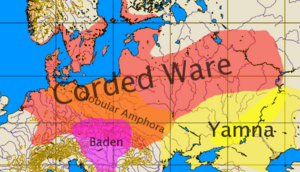
The Ice Age in Latvia ended about 14,000–12,000 years ago. The first people arrived here about 11,000–12,000 years ago during the Paleolithic Age. They were hunters who followed reindeer herds. They camped along rivers and the shore of the Baltic Ice Lake. The earliest tools found near Salaspils are from about 12,000 years ago. They belong to the Swiderian culture.
During the Mesolithic Age (9000–5400 BC), people started to live in permanent settlements. These hunter-gatherers hunted and fished. They built camps near rivers and lakes. About 25 settlements have been found near Lake Lubāns. These people from the Kunda culture made tools and weapons from flint, antler, bone, and wood.
Early Farming and Tribes
The early Neolithic Age (5400–4100 BC) saw the start of pottery making, raising animals, and farming.
During the Middle Neolithic (4100–2900 BC), the Narva culture grew in the region. The people living there were Finnic. They were the ancestors of the Livonians, who are related to Estonians and Finns. They were part of the Pit–Comb Ware culture.
At the start of the Late Neolithic (2900–1800 BC), Balts from the Corded Ware culture settled in Latvia. They were the ancestors of the Latvians. They have lived in most of Latvia since 3000 BCE.
Iron Age and Trade
With iron tools in the early Iron Age (500 BC – 1st century BC), farming got much better. It became the main way people made a living. Bronze, which came from other countries (Latvia has no copper or tin), was used for decorations.
From the Middle Iron Age (400–800 AD), local people started to form their own groups. Baltic peoples became the Curonians, Semigallians, Latgalians, and Selonians. Finnic peoples became the Livonians, Estonians, and Vends. Local leaders started to form small kingdoms.
Latvia became famous as a trading crossroads. The famous trade route from the Varangians to the Greeks went through Latvia via the Daugava river. It connected Scandinavia to the Kievan Rus' and the Byzantine Empire. Ancient Balts were active in this trade. Latvia's coast was known for amber. Latvia is sometimes still called Dzintarzeme (Amberland). In the Middle Ages, amber was often worth more than gold. Latvian amber was known in Ancient Greece and the Roman Empire. The Amber Road was used a lot to move amber to southern Europe.
During the Late Iron Age (800–1200 AD), new farming methods were used. Rye farming began. Local crafts improved with the potter's wheel and better metalworking. Coins from Arab, Western European, and Anglo-Saxon countries have been found. Wooden hill-forts were built to control and protect the land.
Early Latvian Kingdoms
In the 10th century, the ancient Baltic tribes started forming early kingdoms. Different tribal cultures grew in Latvia and northern Lithuania. These included the Curonians, Latgalians, Selonians, Semigallians (Latvian: kurši, latgaļi, sēļi, zemgaļi), and the Western Finnic Livonians. They united under their local chiefs.
The largest tribe was the Latgalians. They were also the most advanced in their society and government. The main Latgalian kingdom, Jersika, was ruled by Greek Orthodox princes. The last ruler of Jersika was King Visvaldis. When he divided his land in 1211, part of it was called "Lettia." This is probably the first time this name was written down.
The Couronians lived in areas that are now Lithuania and the Curonian Spit. They were known for sea invasions, looting, and raiding. On the west coast of the Baltic Sea, they were called the "Baltic Vikings."
Selonians and Semgallians were good farmers. They resisted the Germans for a long time. Livonians lived along the Gulf of Riga. They were fishers and traders. They gave the first German name to this area – Livland.
Before the German invasions in the late 12th century, about 135,000 Baltic people and 20,000 Livonians lived in Latvia.
German Rule (1184–1561)
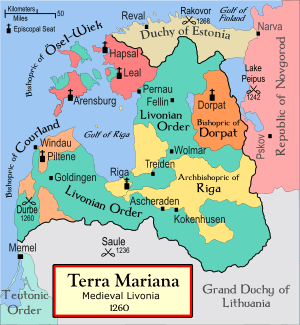
By the late 12th century, traders from Western Europe visited Latvia more often. They traveled along the Daugava river to Kievan Rus'. Among them were German traders. They brought Christian preachers who tried to convert the pagan Baltic and Finnic people to Christianity.
In the early 1180s, Saint Meinhard started his mission among the Daugava Livonians. They did not want to convert. News of this reached Pope Celestine III in Rome. In 1195, it was decided that a Livonian Crusade would happen to force pagans to convert. Meinhard was followed by Berthold of Hanover, who was killed in 1198 near present-day Riga.
Berthold's successor, Bishop Albert of Riga, spent almost 30 years conquering local rulers. He established German rule, which lasted until Latvia's independence in the 20th century. Albert is known for founding Riga in 1201. Riga became the largest city in the southern Baltic Sea region.
A state called Terra Mariana, later the Livonian Confederation, was created in 1207. It included lands belonging to the Church and the Livonian Order in what is now Latvia and Estonia. It was directly under the Pope. In 1228, the Livonian Confederation was officially formed.
The Livonian Brothers of the Sword were founded in 1202 to control the local people. The Livonians were conquered by 1207, and most Latgalians by 1214. After the Brothers of the Sword were defeated at the Battle of Saule in 1236, they joined the Teutonic Order as the Livonian Order.
By the late 13th century, the Curonians and Semigallians were also conquered. The separate tribal kingdoms of ancient Latvians ended as Germans directly ruled the people.
In 1282, Riga (and later Cēsis, Limbaži, Koknese, and Valmiera) joined the Hanseatic League. This made Riga an important trading point between west and east. It also brought closer cultural ties with Western Europe.
Between 1297 and 1330, the Livonian Civil War happened. It started as a fight between the Bishop of Riga and the Livonian Order.
Local people kept many of their freedoms at first. There were not enough Germans to control everything. Peasants had to follow Christian rules, pay taxes, and fight in wars. By the 14th century, peasants had to pay 10% to the Church and work for 4 days a year for their landlords.
In the 15th–16th centuries, the Baltic nobility (German landowners) grew stronger. They owned huge estates and had a lot of power. This German minority became the ruling class. They were traders in cities and landowners in the countryside. They were supposed to care for the peasants, but in reality, peasants were forced into serfdom.
By the 16th century, peasants had to work 4–6 days a week for their landlords and pay 25% in taxes. Many tried to escape to Riga or other manors. In 1494, a law was passed that stopped peasants from leaving their land, making them almost slaves.
The Reformation (a religious movement) reached Livonia in 1521. During a Protestant uprising in 1524, Catholic churches were attacked. In 1525, people were allowed to choose their religion. The first Latvian churches were set up, and services were held in Latvian. Most people became Lutheran by the mid-16th century.
The Livonian Confederation ended during the Livonian War (1558–82). The Livonian Order was dissolved in 1561. The next year, the Livonian Landtag (assembly) asked for protection from the King of Poland and the Grand Duchy of Lithuania. Riga became a Free Imperial City. The rest of the land was divided into the Duchy of Courland and Semigallia (under Poland) and the Duchy of Livonia (under Lithuania).
Livonian War (1558–1583)
The Livonian War ended the Livonian Confederacy. Western Christian countries managed to control this area for the next 150–200 years.
In September 1557, the Livonian Confederation and the Polish–Lithuanian union signed a defense agreement. Ivan the Terrible of Muscovy saw this as a threat. In January 1558, he invaded Livonia, starting the Livonian War. On August 2, 1560, Ivan the Terrible's forces destroyed the last soldiers of the Livonian Order.
In 1561, the weakened Livonian Order was dissolved. Its lands became the Duchy of Livonia (under Lithuania) and the Duchy of Courland and Semigallia (under Poland). The last Master of the Order, Gotthard Kettler, became the first Duke of Courland and became a Lutheran.
Kingdom of Livonia (1570–1578)
In 1560, a bishop named Johannes IV von Münchhausen sold his lands to King Frederick II of Denmark. King Frederick II gave these lands to his younger brother Magnus, Duke of Holstein.
On June 10, 1570, Duke Magnus of Holstein arrived in Moscow. He was crowned King of Livonia. Magnus promised loyalty to Ivan the Terrible and received the kingdom of Livonia from him. Ivan the Terrible's armies were successful at first. They took Polotsk in 1563 and Pärnu in 1575.
In 1578, Magnus recognized the rule of the Polish–Lithuanian Commonwealth. He retired to the Bishopric of Courland. After he died in 1583, Poland took his lands. Denmark left the Baltic by 1585.
Polish-Lithuanian and Swedish Rule (1561–1721/95)
Duchy of Livonia (1561–1621)
Jan Hieronimowicz Chodkiewicz became the first Governor of the Duchy (1566–1578). It was a province of the Grand Duchy of Lithuania until 1569. After the Union of Lublin in 1569, it became a shared territory of the Polish Crown and the Grand Duchy. Muscovy recognized Polish–Lithuanian control of Livonia in 1582.
In 1598, the Duchy of Livonia was divided into three parts:
- Wenden Voivodeship
- Dorpat Voivodeship
- Parnawa Voivodeship
Swedish Livonia (1629–1721)
During the Polish–Swedish War (1600–1629), Riga and most of the Duchy of Livonia came under Swedish rule in 1621. Under Swedish rule, this region was called the "Swedish Bread Basket." It supplied most of the Swedish Kingdom with wheat.
Riga was the second largest city in the Swedish Empire. Livonia helped Sweden control the Baltic Sea. Unlike Swedish Estonia, where local laws stayed the same, Swedish Livonia had new rules. Serfdom was ended on lands owned by the Swedish king. Peasants could get education and jobs in the military or church.
In 1632, the Swedish king Gustavus Adolphus founded Dorpat University. This became an important center for learning in Livonia. The Swedish government helped pay for the translation of the whole Bible into Latvian in 1685. Schools for Latvian peasants were set up. In Latvian history, this time is often called the "good Swedish times."
Duchy of Courland and Semigallia (1562–1795)
After Gotthard Kettler became the first duke, other members of the Livonian Order became nobles. Their lands became their estates. Kettler received almost one-third of the land in the new duchy. Mitau (Jelgava) was made the capital.
When Gotthard Kettler died in 1587, his sons Friedrich and Wilhelm became dukes. They divided the Duchy into two parts in 1596. Friedrich ruled the eastern part, Semigalia (Zemgale). Wilhelm ruled the western part, Courland (Kurzeme). Wilhelm developed metalworking and shipyards. New ships carried Courland's goods to other countries. Wilhelm's conflict with local nobles led to him being removed in 1616. Friedrich then became the only duke.
Under the next duke, Jacob Kettler, the Duchy became very rich. Jacob was a strong supporter of mercantilism (a system where a country tries to get rich through trade). Metalworking and shipbuilding grew a lot. Trading happened with countries like Britain, France, the Netherlands, and Portugal. Jacob created Courland's merchant fleet. Its main ports were in Windau and Libau. The duchy had a large fleet and even started two colonies: St. Andrews Island in Africa and Tobago Island in the Caribbean Sea.
The last duke, Peter von Biron, founded Academia Petrina in 1775. In 1795, Russia decided the future of Courland. The Duke gave up his rights for a large payment.
Enlightenment and Latvians
Enlightenment ideas influenced local Baltic Germans. Two of them helped create the Latvian nation. Gotthard Friedrich Stender wrote the first Latvian-German dictionaries. He also wrote the first encyclopedia and the first Latvian alphabet book.
Garlieb Merkel wrote a book in 1796 called “The Latvians.” In it, he showed the terrible conditions of serfdom under German landlords.
Russian Rule (1721/95–1915/18)
In 1700, the Great Northern War started between Sweden and Russia. Peter the Great wanted to get more access to Baltic ports. In 1710, Russians conquered Riga. Estonia and Livonia surrendered. War losses were made worse by a plague that killed up to 75% of people in some areas.
In 1713, Peter created the Riga Governorate. After changes, the Governorate of Livonia was set up in 1796. Latvians call it Vidzeme Governorate. Sweden officially gave up its claims to Swedish Livonia in 1721. The treaty kept the special rights of the German Baltic nobility. They could keep their financial system, customs, local assemblies, Lutheran religion, and German language. This special position in the Russian Empire was confirmed by all Russian Emperors until Alexander II. Only in 1889 did Russian laws and language become mandatory in schools.
After the First Partition of Poland in 1772, Russia gained Inflanty Voivodeship. This led to Latgalians becoming more separate from other Latvians in culture and language. A large Daugavpils fortress was built there.
After the Third Partition of Poland in 1795, the Courland Governorate was created. Germans kept their special rights for another century. The Russian Empire now controlled all lands where Latvians lived.
In 1812, Napoleon's troops invaded Russia. Prussian units occupied Courland and came close to Riga. The Russian governor-general of Riga, Ivan Essen, burned wooden houses in Riga's suburbs to stop the invaders. Thousands of people lost their homes. However, the Prussians did not attack Riga.
Peasants Gain Freedom
After a rebellion in 1802, a law in 1804 tried to improve peasant life in Livonia. Peasants were no longer tied to the landowner but to the land. Farms could now be passed down in families. The amount of work peasants owed was limited. Nobles opposed this law and changed it in 1809 to give them more power.
In 1819, serfdom was ended in Courland. Peasants gained personal freedom but no land. They had to rent land from landowners. They still needed permission to move to another area. Serfdom ended in Livonia in 1820 with a similar law. In Latgale, serfdom lasted until 1861, when it was abolished in the Russian Empire.
After 1832, peasants could move freely within their region. In 1848, Courland peasants could move to towns and cities. A law in 1849 allowed peasants to rent or buy land. By 1856, only 23% of farmers paid rent; the rest still worked for landlords. By 1914, almost all houses in Courland and Livonia were bought by farmers. This created a class of land-owning Latvian farmers who became more prosperous.
In the 1870s and 1880s, many peasants moved to Siberia, where land was free. By World War I, about 200,000 Latvian farmers had moved to Siberia.
Family Names and Religion
Most Latvian peasants did not have last names until serfdom ended. They were known by their house or manor. Emancipation created a need for identity papers and family names. Livonian peasants chose names by 1826. In Courland, most names were chosen in 1834–1835. Peasants could not choose German noble names. Many chose names related to animals, plants, and trees.
Latvia was mostly Lutheran and Catholic. In 1729, the Herrnhuter Brethren started their mission in Livonia. Many Latvians joined them. This was the first Christian movement where Latvians joined willingly. The Brethren helped Latvians create their own communities.
The Russian government supported the Russian Orthodox Church. But Lutheranism remained the main religion, except in Latgale, where Catholicism was strong. Other Protestant groups also grew. The first Jews were invited to settle in Piltene in 1571. More Jews came after Latvia joined the Russian Empire.
Latvian National Awakening
The Latvian national awakening began after serfs were freed and more people could read and get an education. Educated Latvians no longer wanted to become German.
In 1822, Latviešu avīzes, the first weekly newspaper in Latvian, started publishing. The first Latvian writers appeared. In 1839, a school for elementary teachers opened in Valmiera.
By the mid-19th century, the "Young Latvians" movement began among Latvian intellectuals. This movement was about Latvian culture and had political goals. The Young Latvians often disagreed with the Baltic Germans. During this time, the idea of a united Latvian nation was born. Young Latvians also studied Latvian folklore and ancient beliefs.
In the 1880s and 1890s, Russia started a policy of russification. This aimed to reduce German power in the Baltic regions. Russian language was used in government, courts, and schools. This also hurt the new Latvian culture.
As poverty grew in rural areas and cities like Riga became more industrial, a leftist movement called the "New Current" appeared in the late 1880s. It was led by the future national poet Rainis. This movement was influenced by Marxism and led to the creation of the Latvian Social Democratic Labour Party.
The 1905 Revolution
Latvia started the 20th century with a big uprising during the 1905 Russian Revolution. It began with shooting at demonstrators in Riga on January 13. This led to large strikes and an armed revolt in December. The revolution was against the Russian government and the German landlords. In Latvia, people felt oppressed by the Baltic Germans, who were only about seven percent of the population. They had a feudal system where Latvians were mostly poor and landless.
The revolution involved social democrats, factory workers, peasants, and educated Latvians. Riga had many industrial workers. Over 90% of Latvians could read. This made Latvia ready for both radical leftist ideas and nationalism. The Latvian Social Democratic Workers’ Party (LSDSP) led the way.
After the shooting of demonstrators in St. Petersburg on January 9, 1905, a general strike began in Riga. On January 13, Russian army troops shot at demonstrators, killing 73 people.
In the summer of 1905, the revolution moved to the countryside. New local governments were elected in most parishes. Mass meetings and protests happened. There were violent attacks against German nobles, burning of manor houses, and taking of property. In total, 449 German manor houses were burned.
In the autumn of 1905, armed conflict started between German nobles and Latvian peasants. In Courland, peasants took over towns and set up revolutionary councils. In Vidzeme, fighters controlled a railway line. About a thousand armed clashes happened in Latvia in 1905.
Martial law was declared in Courland in August 1905 and in Vidzeme in November. Special groups of soldiers were sent in December to stop the movement. They killed over 2000 people without trial and burned 300 buildings. Many of those killed were local teachers or peasant activists. Over 5000 people went into exile in Western Europe or the US. The revolution slowly ended by 1907.
World War I
On August 1, 1914, Germany declared war on Russia. Courland Governorate, bordering Germany, was immediately involved. On August 2, German warships shelled Liepāja. On August 19, the German navy tried to capture Užava Lighthouse but failed.
Many Latvians served in Russian units near the German border. They fought in early battles in East Prussia. Total Latvian losses in these battles may have been 25,000 dead.
German Attack and Refugees
By May 1915, the war reached most of Latvia. On April 30, the Russian Commander-in-Chief ordered all Jews to leave Courland within 24 hours. On May 7, Germans captured Liepāja and Kuldīga.
On June 29, the Russian Supreme Command ordered everyone in Courland to evacuate. About 500,000 refugees fled east. Much of the crops and houses were destroyed by the army so Germans couldn't use them. Many refugees settled in Russia, living in poor conditions and suffering from hunger and disease. The Latvian Refugee Aid Central Committee was set up in Petrograd. It helped refugees with housing, schools, and hospitals. Many refugees returned to Latvia only after 1920.
On July 19, 1915, the Russian War Minister ordered factories in Riga to be evacuated with their workers. About 30,000 railway wagons carried machines and equipment away. This reduced Riga's population by about 50%. This action largely destroyed Riga as a major industrial center until Soviet times.
On August 1, Germans captured Jelgava, the capital of Courland. By October 23, Germans captured Ilūkste and were close to Daugavpils.
Latvian Riflemen
After Germans captured several towns in July 1915, a call was made to form volunteer Latvian Riflemen units. These units started forming in August. From 1915 to 1917, the Riflemen fought in the Russian army against the Germans along the Daugava River. They suffered heavy losses in the Christmas Battles in December 1916 and January 1917. Many were buried in the new Riga Brothers' Cemetery.
After the Russian army started to collapse in early 1917, many Riflemen joined the Bolsheviks. A German offensive was successful, and they entered Riga on September 3, 1917.
In November 1917, the Communist Bolsheviks took power in Russia. In March 1918, the Treaty of Brest-Litovsk was signed. Russia gave Courland and Livonian Governorate to the Germans. The Germans set up an occupation government until November 11, 1918. During this time, Germans tried to create the United Baltic Duchy.
War Damages
A survey in 1920 showed that 56.7% of parishes had war damages. The population decreased from 2.55 million to 1.59 million. The number of ethnic Latvians has never reached 1914 levels again. 87,700 buildings were destroyed. 27% of farmland was ruined. Much of the industry was moved to Russia and lost. Ports, bridges, and railways were damaged.
Path to Independence (1917–1920)
World War I directly involved Latvians and their land. This led to the idea of Latvian statehood. During the war, many Latvians became refugees. Local politicians gained experience helping refugees and organizing Latvian cultural life. Latvian riflemen fought for Russia but became more radical. During the Russian Civil War, some Red riflemen fought for the Bolsheviks. Meanwhile, Germany planned to take over Latvian lands. During the collapse of the Russian and German empires, different groups tried to create a state in Latvia. Not all of them wanted a fully independent Latvian state.
Provisional Councils and Iskolat
After the February Revolution in Russia, most Latvians hoped for a federal status within Russia. "Free Latvia in Free Russia" was a popular slogan. In March 1917, the Vidzeme Land Congress created the Provisional Land Council of Vidzeme. Courland was occupied by Germans, who wanted to create a puppet Duchy to annex it to Germany. Latgalian areas wanted to unite with other Latvian provinces.
On July 5, 1917, the Russian Provisional Government recognized the elected Land councils. Latvians asked for broad local self-rule. In August 1917, leftist Social Democrats, influenced by Bolsheviks, created the Iskolat government. After Riga was occupied by Germans in September 1917, Iskolat moved to Vidzeme and took power. The Iskolat Republic existed from November 1917 to March 1918. It was disbanded after the Brest-Litovsk treaty gave Latvian lands (except Latgale) to Germany.
Latvian National Council
In October 1917, politicians met in Petrograd to create a united Council of all Latvian parties. On November 29, 1917, the Latvian Provisional National Council was established in Valka. On December 2, 1917, it declared Latvia's autonomy and said it was the only representative of Latvians. The Council wanted a Constitutional Assembly, political self-rule, and the uniting of all Latvian lands.
The National Council sent a group to Allied countries to get support for an independent Latvia. The Bolshevik-controlled Iskolat tried to ban the Provisional Council in December 1917.
On January 5, 1918, during the only meeting of the democratically elected Russian Constituent Assembly, Latvian deputy Jānis Goldmanis read a declaration of Latvia's separation from Russia. On January 30, 1918, the Latvian National Council declared that Latvia should be an independent, democratic republic, uniting Kurzeme, Vidzeme, and Latgale.
On March 3, 1918, Soviet Russia signed the Treaty of Brest-Litovsk with Germany. Russia gave up Kurzeme and Vidzeme. The National Council protested this division of Latvian lands.
On November 11, 1918, the British Empire recognized the Latvian National Council as the de facto (actual) government.
People's Council and Independence
After Germany's collapse on November 9, the National Council and other groups started talks to unite. Social Democrats wanted a socialist state, which other parties didn't accept. They insisted on creating a new unity organization.
On November 17, 1918, Latvian groups finally united in the People's Council. On November 18, 1918, it declared the Independence of the Republic of Latvia and created the Latvian Provisional Government.
A few days later, Soviet Russia started an offensive to regain its western lands. The War of Independence began. The left wing of Latvian Social Democrats joined the Bolsheviks. On December 17, 1918, a Provisional government of Workers and Peasants, led by Pēteris Stučka, declared Soviet rule. On December 18, Lenin officially recognized the new Soviet Latvia.
War of Independence
On December 1, 1918, Soviet Russia invaded Latvia. Many of the invading soldiers were Red Latvian Riflemen. The Soviet offensive met little resistance. The Social Democratic party left the People's Council but rejoined in April 1918. Riga was captured by the Soviet Army on January 3, 1919. By the end of January, the Provisional Government and German units had retreated to Liepāja.
The Latvian Socialist Soviet Republic was officially declared on January 13. It had political, economic, and military support from Soviet Russia. Stučka set up a strict communist government. They nationalized businesses, took property, and executed "class enemies." About 1000 people were executed. Due to food shortages, 8590 people starved to death in Riga.
On March 3, 1919, German and Latvian forces started a counterattack. On April 16, the Baltic nobility organized a coup d'état in Liepāja. A puppet government was set up. The provisional national government took refuge on a ship under British protection. On May 22, 1919, Riga was recaptured by German forces. At the same time, the Estonian Army and the North Latvian Brigade started a big attack against the Soviets in northern Latvia. By mid-June, Soviet rule was only in Latgale.
In June 1919, fighting started between the Baltische Landeswehr (German forces) and the Estonian 3rd division. The Estonians defeated the Germans in the Battle of Wenden on June 23. An agreement was signed, and the Germans had to leave Latvia.
Instead, the German forces joined the West Russian Volunteer Army. On October 5, they attacked Riga. On November 11, the Latvian counterattack began. By the end of the month, the Germans were driven out of Latvia. British naval artillery supported Latvian forces in Riga.
On January 3, 1920, united Latvian and Polish forces attacked the Soviet army in Latgale. After the Battle of Daugavpils, they liberated Daugavpils. By the end of January, they reached Latvia's border. Peace talks with the Soviets soon began.
Peace and Recognition
At the 1919 Paris Peace conference, Latvia tried to get international recognition for its independence. But the Allies still hoped for a democratic Russia that would give Latvia some self-rule. The situation in Latvia was also unstable, with three different governments fighting for control.
On August 11, 1920, the Latvian–Soviet Peace Treaty was signed. Soviet Russia gave up all claims to Latvia. Russia recognized Latvia's independence and sovereignty forever.
In 1920, Latvia, Lithuania, and Estonia tried to join the League of Nations but were not accepted.
As the Soviet victory in the Russian Civil War became clear, the Allied Supreme War Council (including the United Kingdom, France, Belgium, Italy, and Japan) recognized Latvia's independence on January 26, 1921. Many other countries followed. Latvia joined the League of Nations on September 22, 1921. The US recognized Latvia in July 1922. Before 1940, 42 countries recognized Latvia.
Parliamentary Era (1920–1934)
After Latgale was freed from the Soviets in January 1920, elections for the Constitutional Assembly of Latvia happened on April 17–18, 1920. Latvia's population had dropped by almost a million. 50 parties and candidates competed for 150 seats. About 85% of voters participated, and 16 parties were elected. The Latvian Social Democratic Workers' Party won 57 seats, the Latvian Farmers' Union 26. This voting pattern continued in future parliaments – many parties meant unstable coalition governments. Between 1922 and 1934, Latvia had 13 governments and 9 Prime Ministers.
On February 15, 1922, the Constitution of Latvia was passed. In June, a new election law was passed, leading to the election of the parliament – the Saeima.
During this time, four national elections took place. Three State Presidents were elected: Jānis Čakste (1922–27), Gustavs Zemgals (1927–30), and Alberts Kviesis (1930–36).
Foreign Relations
Independent Latvia's first foreign goals were to make peace with Soviet Russia and Germany, get international recognition, and join the League of Nations. Zigfrīds Anna Meierovics worked hard to achieve these.
Hopes for a union of Baltic countries (Poland, Lithuania, Latvia, Estonia, and Finland) faded after 1922. After that, Latvia strongly supported Baltic unity and the Baltic Entente. On November 1, 1923, Latvia and Estonia signed a military alliance. Latvia tried to keep good relations with Russia and Germany. Foreign governments opened 21 embassies and 45 consulates in Latvia by 1928.
Politics and Economy
The Latvian Social Democratic Workers' Party, as the largest party, held the position of Speaker of the Saeima in all parliaments. They usually avoided joining governments. Governments were often led by the center-right Farmers' Union or a coalition of smaller parties.
The Social Democrats were split. The main party was led by Pauls Kalniņš. A smaller group, the Social Democrat Minority Party, was more moderate. The main Social Democrat party supported international socialist ideas. Their popularity slowly fell.
The Latvian Farmers' Union was the second-largest party. It was the largest conservative party. It was led by Kārlis Ulmanis. His decreasing popularity might have been a reason for the May 15, 1934 Latvian coup d'état.
The young Latvian state had two main economic challenges: rebuilding factories and giving land from German nobles to Latvian farmers.
The Constitutional Assembly passed a land-reform law. Landowners were left with 50 hectares each. Their extra land was given to landless peasants for free. In 1897, 61.2% of rural people had no land. By 1936, this was down to 18%. Farmed land reached pre-war levels by 1923.
Before World War I, about 2% of landowners owned 53% of the land. The Agrarian Reform Law of September 16, 1920, created the State Land Fund. It took over 61% of all land. German nobles were left with no more than 50 hectares. This ended their manor-house system. Many sold their property and left for Germany. Former manor houses became schools, government buildings, or hospitals. The land was given to a new class of small farmers, called Jaunsaimnieki (New farmers). They had to build their farms from scratch. They developed dairy farming, and butter, bacon, and eggs became new exports.
On March 27, 1919, the Latvian Provisional Government introduced the Latvian ruble. Due to high inflation, the new Latvian lats was introduced in 1922. One lats was equal to 50 rubles. The Bank of Latvia was established in 1923.
Between 1923 and 1930, the state budget had extra money. About 25.5% went to defense, 11.2% to education, and 23.4% to building projects. The state's alcohol monopoly brought in about 15% of government income.
Rebuilding industry was hard. Before World War I, 80% of industrial goods went to Russia. Latvia signed a trade agreement with the Soviet Union in 1927, but trade was not high. By the late 1920s, Latvia's biggest export markets were Germany (35.6%) and the United Kingdom (20.8%). Latvia had to import almost all its modern machines and fuels.
The Great Depression reached Latvia in mid-1930. Exports fell, and imports were limited to save money. State monopolies for sugar and bacon were created. To stop banks from failing, a law in 1931 limited how much money people could take out. In 1932, the trade agreement with the Soviet Union ended. Industrial unemployment was highest in January 1932. National income fell a lot.
Economic recovery started in 1933. Production increased by about 30%. The state budget deficit fell.
Ulmanis' Rule (1934–1940)
On the night of May 15–16, 1934, Prime Minister Kārlis Ulmanis and Minister of War Jānis Balodis took power in a peaceful government takeover. Parliament and the Constitution were suspended. A state of emergency was declared. All political parties were banned, and the press was censored. Leaders from extreme right and left groups were arrested.
Economy Under Ulmanis
The new Ulmanis government increased state control over the economy. In 1934, the Chamber of Trade and Industry was created. Chambers for agriculture, artisans, and labor followed. The state helped farmers by delaying bankruptcy sales and refinancing their debts. In 1934, the state took control of cooperative societies. The dairy industry was placed under state control.
In 1935, a state-controlled Credit Bank of Latvia was created. This reduced the role of foreign money. Many state-owned industry monopolies and companies were created. Foreign, Baltic German, and Jewish-owned companies were often bought out or closed. By 1939, the state owned 38 such companies. The new JSC Vairogs made railway carriages and Ford-Vairogs cars. VEF made the world's smallest Minox cameras and experimental aircraft. Between 1936 and 1939, the Ķegums Hydroelectric Power Station, the largest in the Baltics, was built.
After Western countries stopped using the gold standard, the Latvian lats was linked to the British pound in September 1936. This made Latvian exports stronger. By 1939, after a boom in agricultural exports, Latvia was the richest of the Baltic countries. Its GDP per person was higher than Finland or Austria.
However, it took almost ten years to recover from the Great Depression. National income slowly rose back to 1929 levels by 1938.
When World War II started, Latvia declared complete neutrality. But it was cut off from the UK market because Germany controlled the Baltic Sea. Austerity measures were introduced in September 1939. A treaty with the Soviet Union in October 1939 created new trade opportunities. Latvia exported food and received oil, fuel, and chemicals. A trade agreement was also signed with Nazi Germany in December 1939.
Latvian farmers usually relied on seasonal workers from Poland. The war stopped this. In spring 1940, new rules made work service compulsory for state employees, students, and schoolchildren.
Foreign Relations Under Ulmanis
In October 1936, Latvia was elected as a temporary member of the League of Nations Council for three years. In 1935, the embassy in Washington was reopened. It later became important for the Latvian Diplomatic Service during 50 years of Soviet occupation.
After the Munich Agreement showed that the system of collective security had failed, Latvia declared absolute neutrality on December 13, 1938. On March 28, 1939, the Soviet Union announced its interest in keeping Latvia's independence. On June 7, 1939, Latvia and Germany signed a non-aggression treaty.
-
Minox camera, world's smallest.
World War II and Occupations
Soviet Occupation (1940)
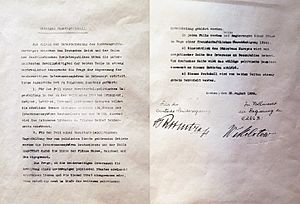
The Soviet Union planned to take over the Baltic countries. This was agreed in the Molotov–Ribbentrop Pact with Nazi Germany on August 23, 1939. Under threat of invasion, Latvia (along with Estonia and Lithuania) signed a treaty with the Soviet Union. This allowed up to 25,000 Soviet troops to be stationed in Latvia. Following Germany's lead, Latvia agreed on October 30, 1939, to "repatriate" ethnic Germans. Most of them had lived in Latvia for many generations.
Seven months later, the Soviet foreign minister Vyacheslav Molotov accused the Baltic states of working against the Soviet Union. On June 16, 1940, the Soviet Union issued an ultimatum, threatening invasion. It demanded that the government be replaced and an unlimited number of Soviet troops be allowed in. Knowing the Red Army had entered Lithuania the day before and was ready at the border, the Latvian government agreed. Soviet troops occupied the country on June 17. Fake elections were held on July 14–15, 1940. The results were announced in Moscow 12 hours before voting ended. The new "People's Assembly" declared Latvia a Socialist Soviet Republic and asked to join the Soviet Union on July 21. Latvia became part of the Soviet Union on August 5, 1940.
In spring 1941, the Soviet government planned to deport people who were against the Soviet system from the Baltic states. On the night of June 13–14, 1941, 15,424 people from Latvia were deported to camps and special settlements, mostly in Siberia.
Nazi German Occupation (1941–1944)
The Nazi invasion, launched a week later, stopped plans to deport more people. Nazi troops occupied Riga on July 1, 1941. Immediately, the process of killing the Jewish and Gypsy population began. Many killings happened in Rumbula. The killings were done by German groups and by Latvian helpers. The Arajs Commando alone killed about 26,000 Jews. By the end of 1941, almost all Jews were killed or put in concentration camps. About 25,000 Jews were brought from other countries, and around 20,000 of them were killed. The Holocaust killed about 85,000 people in Latvia, most of whom were Jews.
Many Latvians resisted the German occupation. The resistance was split between groups wanting independence and groups supporting the Soviets. The Nazis planned to make the Baltics German after the war. In 1943 and 1944, two divisions of Waffen-SS were formed from Latvian conscripts and volunteers to help Germany against the Red Army.
-
Last troops leaving Liepāja port, May 8, 1945.
Soviet Era (1944–1990)
In 1944, Soviet military advances led to heavy fighting in Latvia. This ended with another German defeat. Riga was taken back by the Soviet Red Army on October 13, 1944. The Courland Pocket (a group of German forces) held out until May 9, 1945. During the war, both sides forced Latvians to join their armies, leading to many deaths. In 1944, part of Latvia came under Soviet control again. Latvian national partisans started fighting against the new Soviet occupation. 160,000 Latvians fled to Germany and Sweden to escape the Soviet army.
Changes in Leadership and Population
On March 5, 1953, Joseph Stalin died. His successor was Nikita Khrushchev. A period of change, known as the Khrushchev Thaw, began. However, attempts by Latvian communists like Eduards Berklavs to gain more self-rule for Latvia and protect the Latvian language failed. In 1959, after Khrushchev visited Latvia, these national communists lost their jobs, and Berklavs was sent to Russia.
Because Latvia still had good infrastructure and educated people, Moscow decided to build some of the Soviet Union's most advanced factories there. New industries were created, including a large machinery factory RAF in Jelgava. There were also electrical factories in Riga and chemical factories in Daugavpils, Valmiera, and Olaine. However, there were not enough people to work in these new factories. To increase production, more immigrants from other Soviet republics were moved to Latvia. This significantly decreased the proportion of ethnic Latvians.
By 1989, ethnic Latvians made up about 52% of the population. Before the war, they were 77%. In 2005, there were 1,357,099 ethnic Latvians. However, as a proportion of the total population, Latvians now make up about 60%.
-
Soviet nomenklatura sanatorium in Jūrmala.
Restoration of Independence
Changes in the communist system began in the mid-1980s in the USSR under Mikhail Gorbachev. In Latvia, several large political groups formed to use this opportunity. These included the Popular Front of Latvia, the Latvian National Independence Movement, and the Citizens' Congress. These groups started pushing for Latvia to become independent again.
On the 50th anniversary of the Molotov-Ribbentrop Pact (August 23, 1989), Latvians, Lithuanians, and Estonians joined hands in a human chain. This Baltic Way stretched 600 kilometers from Tallinn, to Riga, to Vilnius. It showed the united wish of the Baltic States for independence.
Further steps towards full independence were taken on May 4, 1990. The Latvian SSR Supreme Council, elected in the first democratic elections since the 1930s, adopted a declaration restoring independence. This included a transition period from being part of the Soviet Union to full independence. In January 1991, pro-communist groups tried to restore Soviet power by force. Latvian demonstrators managed to stop Soviet troops from taking over important places (January 1991 events in Latvia). On August 21, after a failed coup d'état in Moscow, parliament voted to end the transition period. This restored Latvia's pre-war independence. On September 6, 1991, Latvian independence was recognized by the Soviet Union again.
Modern History
Soon after regaining independence, Latvia, which had been a member of the League of Nations before World War II, joined the United Nations. In 1992, Latvia became eligible for the International Monetary Fund. In 1994, it joined the NATO Partnership for Peace program and signed a free trade agreement with the European Union. Latvia became a member of the European Council and a candidate for EU and NATO membership. Latvia was the first of the three Baltic nations to be accepted into the World Trade Organization.
At the end of 1999 in Helsinki, European Union leaders invited Latvia to start talks about joining the EU. In 2004, Latvia achieved its main foreign policy goals: membership in the European Union and NATO. On April 2, Latvia became a member of NATO. On May 1, Latvia, along with the other two Baltic States, became a member of the European Union. About 67% of voters supported EU membership in a September 2003 referendum. Latvia signed the Schengen agreement on April 16, 2003, and started using it on December 21, 2007. On January 1, 2014, Latvia joined the eurozone, using the euro as its currency.
In May 2023, the parliament elected Edgars Rinkevics as the new President of Latvia. He became the European Union’s first openly gay head of state.
Regional Timeline
Here's how the areas that make up modern Latvia fit into history:
| Century | ||||||
|---|---|---|---|---|---|---|
| North Estonia | South Estonia | North Latvia | South Latvia | Lithuania | ||
| 10th | Finnic tribes | Baltic tribes | Baltic tribes | |||
| 11th 12th | Ancient Estonia | Ancient Latvia | Ancient Lithuania | |||
| 13th | Danish Estonia | Livonian Order | Duchy of Lithuania | |||
| 14th | Polish–Lithuanian Commonwealth (Grand Duchy of Lithuania) | |||||
| 15th | ||||||
| 16th | Swedish Estonia | Polish–Lithuanian Commonwealth (Duchy of Livonia) | ||||
| 17th | Swedish Livonia | |||||
| 18th | Russian Empire (Governorate of Estonia) | Russian Empire (Governorate of Livonia) | Polish–Lithuanian Commonwealth (Duchy of Courland and Semigallia) | |||
| 19th | Russian Empire (Courland Governorate) | Russian Empire (Government of Kaunas) | Russian Empire (Vilna Governorate) | |||
| 20th | Republic of Estonia | Republic of Latvia | Republic of Lithuania | |||
| 21st | Republic of Estonia (EU) | Republic of Latvia (EU) | Republic of Lithuania (EU) | |||
See also
 In Spanish: Historia de Letonia para niños
In Spanish: Historia de Letonia para niños
- Dissolution of the Soviet Union
- History of Riga
- Latvian independence movement (1940–1991)
- Latvian diplomatic service (1940–1991)
- List of presidents of Latvia
- Prime Minister of Latvia
- Livonia
- Politics of Latvia
|
EasyTimeline 1.90
|


